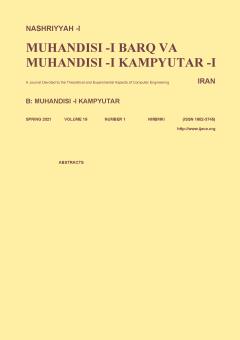الگوریتم جدید ضرب دیجیتال با سرعت بالا بدون خطلوله با قابلیت بسط آسان
الموضوعات : مهندسی برق و کامپیوترابراهیم حسینی 1 , مرتضی موسی زاده 2
1 - دانشگاه ارومیه
2 - دانشگاه ارومیه
الکلمات المفتاحية: ضربکننده پرسرعت, جمعکننده بدون خط لوله, جمعکننده درختی Kogge-Stone اصلاحشده, جمعکننده پیشبینی بیت نقلی,
ملخص المقالة :
در این مقاله یک الگوریتم جدید برای ضربکننده دیجیتال بدون علامت با مشخصات سرعت بالا و توان مصرفی کم بدون خط لوله که به آسانی برای تعداد بیتهای بیشتر نیز بسط مییابد پیشنهاد شده است. بلوکهای این ضربکننده به صورت موازی کار میکنند و این عملکرد موجب افزایش چشمگیر سرعت ربکننده خواهد شد. در این الگوریتم، بیتهای ورودی به دستههای کوچکتری تقسیمبندی میشوند که ضرب این دستهها به صورت موازی و همزمان انجام خواهند گرفت. این تقسیمبندی تا رسیدن به کمترین تعداد بیت ورودی یعنی 2×2 ادامه مییابد. در محاسبه حاصلضرب هر یک از دستهها، از الگوریتم پیشنهادی استفاده گردیده که منجر به تسریع حاصلضرب هر دسته شده است و نتیجه نهایی از حاصلجمع این دستههای کوچکتر به دست خواهد آمد. برای جمعکردن دستههای کوچکتر از جمعکنندههای درختی اصلاحشده که بتواند منجر به افزایش سرعت ضرب شود استفاده گردیده است. ضربکنندههایی با طول بیتهای ورودی 2، 4، 8، 16، 32 و 64 با استفاده از الگوریتم پیشنهادی در فناوری 180 نانومتر و 90 نانومتر پیادهسازی شدهاند که برای طول بیت ورودی 32 بیت در فناوری 180 نانومتر، تأخیر 05/3 نانوثانیه و مصرف توان 40 میلیوات و در فناوری 90 نانومتر، تأخیر 53/1 نانوثانیه و مصرف توان 7/9 میلیوات میباشد. همچنین با استفاده از روش پیشنهادی تخمین زده میشود که تأخیر ضربکننده 128×128 در فناوری 180 و 90 نانومتر به ترتیب برابر با 4/5 نانوثانیه و 5/2 نانوثانیه شود. با توجه به نتایج و در مقایسه با سایر کارهای گزارششده در مقالات و در پروسس یکسان، بدون افزایش توان مصرفی و با مساحت سیلیکون 5/1 برابر، سرعت ضربکننده پیشنهادی بیش از 2 برابر افزایش یافته است.
[1] A. D. Booth, "A signed binary multiplication technique," the Quarterly J. of Mechanics and Applied Mathematics, vol. 4, no. 2, pp. 236-240, 1951.
[2] C. S. Wallace, "A suggestion for a fast multiplier," IEEE Trans. on Electronic Computers, vol. 13, no. 1, pp. 14-17, Feb. 1964.
[3] O. L. MacSorley, "High-speed arithmetic in binary computers," in Proc. of the IRE, vol. 49, no. 1, pp. 67-91, Jan. 1961.
[4] D. A. Pucknell and K. Eshraghian, Basic VLSI Design: Systems and Circuits, Prentice Hall Englewood Cliffs, New Jersey, USA, 1988.
[5] R. Fried, "Minimizing energy dissipation in high-speed multipliers," in Proc. of the Int. Symp. on Low Power Electronics and Design, pp. 214-219, Monterey, CA, USA, 8-20 Aug. 1997.
[6] H. Ghasemizadeh, E. Azadi, K. Hadidi, and A. Khoei, "A 1.6 GHz 16×16-bit low-latency pipelined booth multiplier," in Proc. 19th Iranian Conf. on Electrical Engineering, ICEE'11, 6 pp., Tehran, Iran, 17-19 May 2011.
[7] A. Weinberger and J. Smith, "A logic for high-speed addition," Nat. Bur. Stand. Circ, vol. 591, pp. 3-12, 1958.
[8] L. Morgan and D. Jarvis, "Transistor logic using current switching and routing techniques and its application to a fast 'carry' propagation adder," Proc. of the IEE-Part B: Electronic and Communication Engineering, vol. 106, pp. 467-468, 1959.
[9] M. Lehman and N. Burla, "Skip techniques for high-speed carry-propagation in binary arithmetic units," IRE Trans. on Electronic Computers, vol. 10, no. 4, pp. 691-698, Dec. 1961.
[10] R. P. Brent and H. T. Kung, "A regular layout for parallel adders," IEEE Trans. on Computers, vol. 31, no. 3, pp. 260-264, Mar. 1982.
[11] J. Sklansky, "Conditional-sum addition logic," IRE Trans. on Electronic Computers, vol. 9, no. 2, pp. 226-231, Jun. 1960.
[12] P. M. Kogge and H. S. Stone, "A parallel algorithm for the efficient solution of a general class of recurrence equations," IEEE Trans. on Computers, vol. 22, no. 8, pp. 786-793, Aug. 1973.
[13] H. C. Chow and I. C. Wey, "A 3.3 V 1 GHz high speed pipelined booth multiplier," in Proc. IEEE Int. Symp. on Circuits and Systems, ISCAS'02, pp. 1-1, Phoenix-Scottsdale, AZ, USA, 26-29 May 2002.
[14] K. H. Chen and Y. S. Chu, "A low-power multiplier with the spurious power suppression technique," IEEE Trans. on Very Large Scale Integration (VLSI) Systems, vol. 15, no. 7, pp. 846-850, Jul. 2007.
[15] A. Saha, D. Pal, and M. Chandra, "Low-power 6-GHz wave-pipelined 8b×8b multiplier," IET Circuits, Devices & Systems, vol. 7, no. 3, pp. 124-140, May 2013.
[16] Z. Huang and M. D. Ercegovac, "High-performance low-power left-to-right array multiplier design," IEEE Trans. on Computers, vol. 54, no. 3, pp. 272-283, 2005.
[17] S. R. Kuang, J. P. Wang, and C. Y. Guo, "Modified booth multipliers with a regular partial product array," IEEE Trans. on Circuits and Systems II: Express Briefs, vol. 56, no. 5, pp. 404-408, May 2009.
[18] V. S. Dimitrov, K. U. Jarvinen, and J. Adikari, "Area-efficient multipliers based on multiple-radix representations," IEEE Trans. on Computers, vol. 60, no. 2, pp. 189-201, Feb. 2011.
[19] P. Mokrian, M. Ahmadi, G. Jullien, and W. Miller, "A reconfigurable digital multiplier architecture," in Proc. Canadian Conf. on Electrical and Computer Engineering. Toward a Caring and Humane Technology, CCECE’03, vol. 1, pp. 125-128, Montreal, Canada, 4-7 May 2003.


